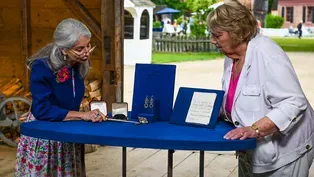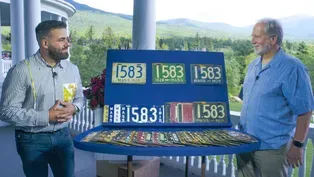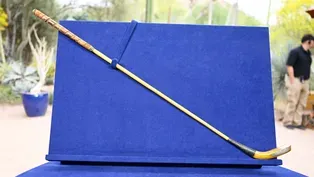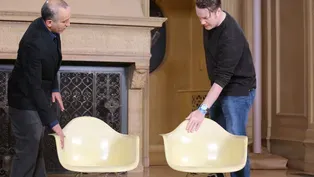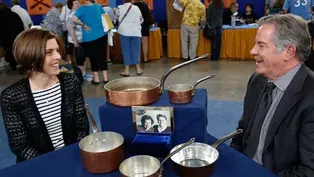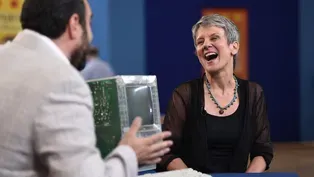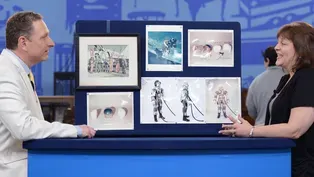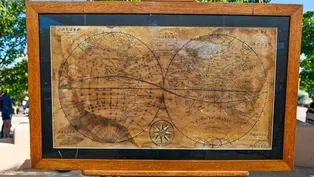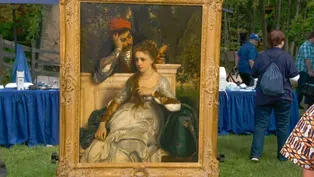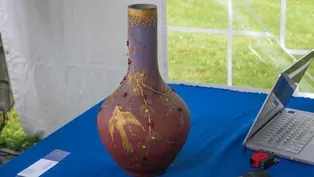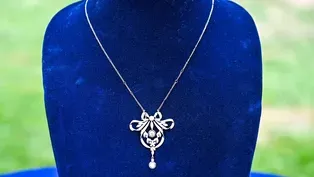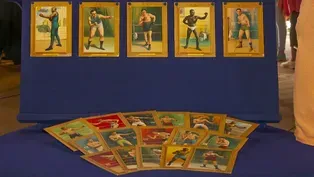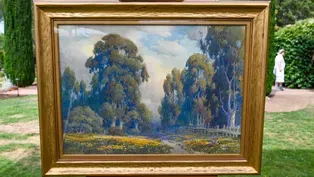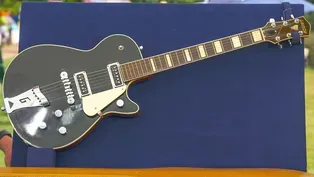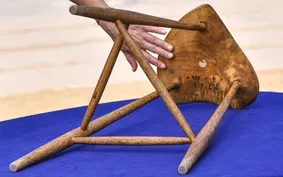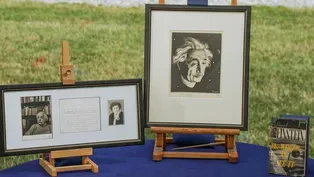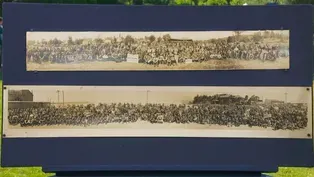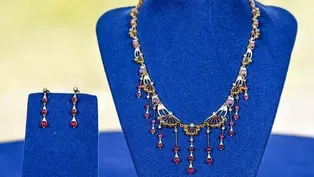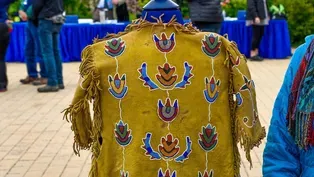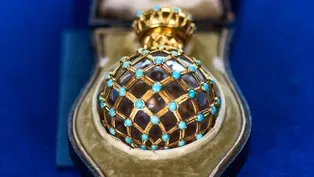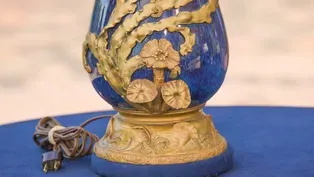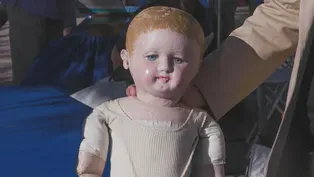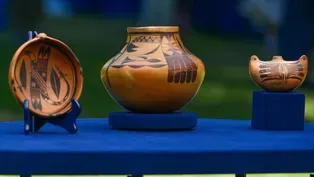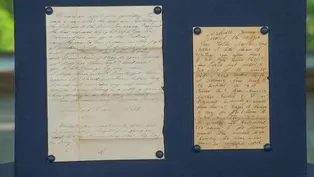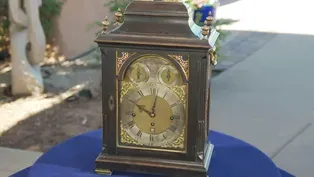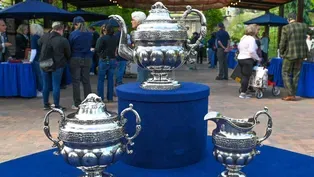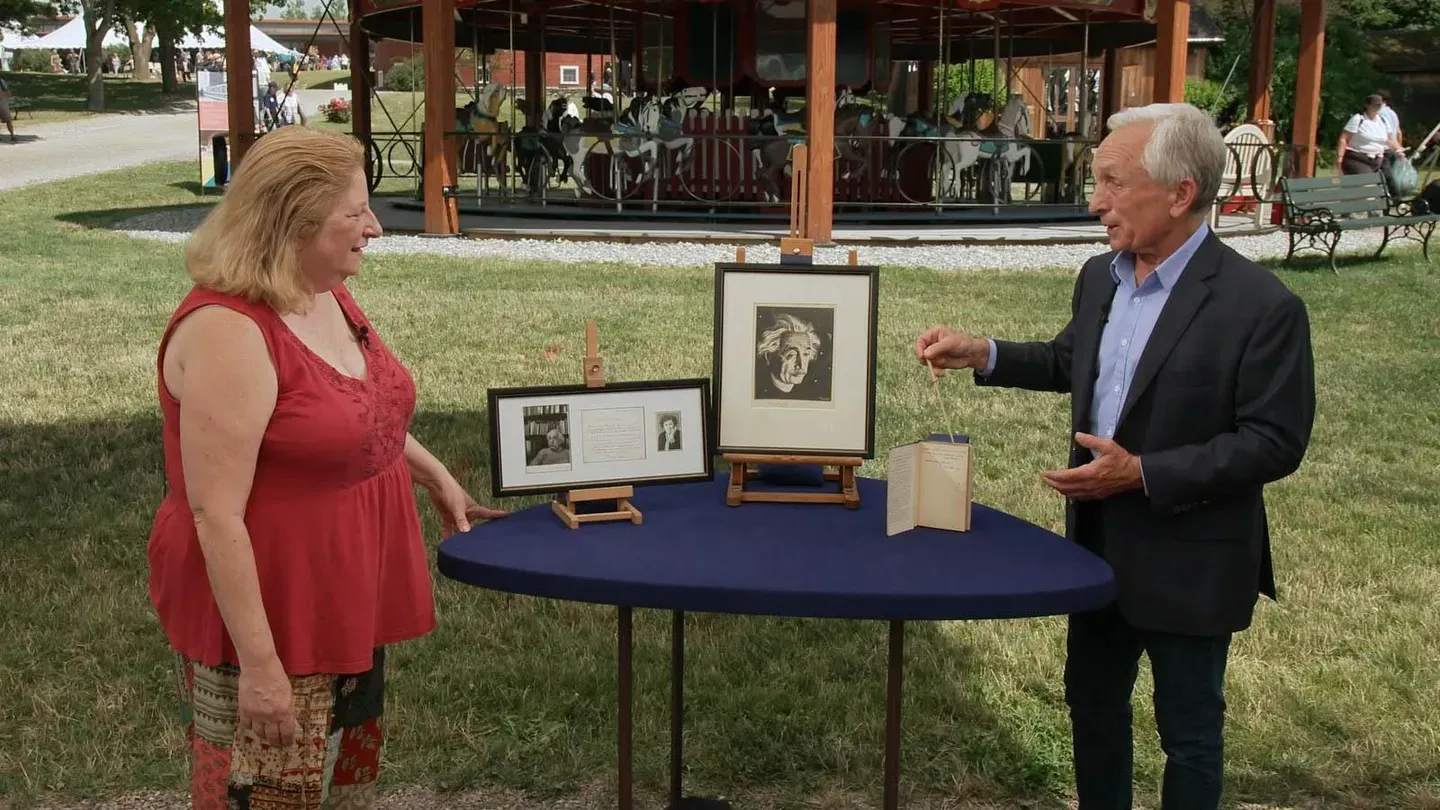

Junk in the Trunk 12
Season 27 Episode 25 | 52m 26sVideo has Closed Captions
Catch a trunkful of never-before-seen treasures from ROADSHOW's season 27 tour.
Catch a trunkful of never-before-seen treasures from ROADSHOW's season 27 tour, like a 1791 Jane Young world map needlework, an Albert Einstein collection and Carlo Giuliano earrings & necklace, ca. 1890. One treasure is up to $120,000!
Funding for ANTIQUES ROADSHOW is provided by Ancestry and American Cruise Lines. Additional funding is provided by public television viewers.

Junk in the Trunk 12
Season 27 Episode 25 | 52m 26sVideo has Closed Captions
Catch a trunkful of never-before-seen treasures from ROADSHOW's season 27 tour, like a 1791 Jane Young world map needlework, an Albert Einstein collection and Carlo Giuliano earrings & necklace, ca. 1890. One treasure is up to $120,000!
How to Watch Antiques Roadshow
Antiques Roadshow is available to stream on pbs.org and the free PBS App, available on iPhone, Apple TV, Android TV, Android smartphones, Amazon Fire TV, Amazon Fire Tablet, Roku, Samsung Smart TV, and Vizio.
Buy Now

ANTIQUES ROADSHOW 2025 Tour!
Enter now for a chance to win free tickets to ANTIQUES ROADSHOW's 2025 Tour! Plus, see which cities we're headed to!Providing Support for PBS.org
Learn Moreabout PBS online sponsorshipMore from This Collection
Video has Closed Captions
Travel to all five cities of ROADSHOW's Season 28 Tour for never-before-seen appraisals! (52m 25s)
Video has Closed Captions
Discover all new appraisals from ROADSHOW’s Season 26 tour, like a find of up to $75,000! (52m 27s)
Video has Closed Captions
Discover never-before-seen surprises from our Season 24 tour. One is worth up to $100K! (52m 45s)
Video has Closed Captions
Discover never-before-seen appraisals from all Season 23 cities, like a $40K-$60K find! (52m 29s)
Video has Closed Captions
ROADSHOW’s bigger-than-ever 2014 season includes a second hour of junk! (53m 10s)
Video has Closed Captions
Discover more previously unseen appraisals from our eight-city tour. (53m 10s)
Video has Closed Captions
See never-before-aired appraisals from this season’s eight-city tour. (53m 6s)
Providing Support for PBS.org
Learn Moreabout PBS online sponsorship♪ ♪ CORAL PEÑA: We've got extra treasures from our 27th season tour.
You can touch something that Einstein touched.
I mean, it just sends a thrill.
Oh, gosh.
Wow.
(chuckles) PEÑA: Right now in "Antiques Roadshow: Junk In the Trunk."
♪ ♪ PEÑA: Nashville's Cheekwood Estate and Gardens was our first stop in 2022.
Once home to Leslie and Mabel Cheek, this masterful combination of architecture, design, and nature was planned by Bryant Fleming and was completed in 1932.
Today, the combination of Cheekwood's beautiful surroundings and the treasures of our guests is creating excitement.
Mm-hmm.
That's the Vicksburg and this is the other one.
♪ ♪ MAN: These are our group of Civil War letters that are from two brothers that were at the Siege of Vicksburg.
They wrote the letters together and signed them Lem and Cam McNabb.
From what little research that I have done, it looks like Lem was probably captured at Vicksburg, and then later died in prison.
And the, Cam went on to be also captured at, at Vicksburg, paroled on July the 4th of '63, and joined the Union Army February of '64 in Nashville.
And you're right, we did a little bit of research on the brothers.
Mm-hmm.
And Lemuel was actually captured on May 17 at the Battle of Big Black River Bridge.
Somewhere between 260 and 329 members of that regiment were captured that day.
(whispers): Wow.
Those guys all got a ticket up North to Fort Delaware.
Mm.
And the reason we don't hear from Lem anymore is, a few months later, he dies in prison.
Campbell takes another way out.
He gets captured when the city falls.
He's part of the regiment that survives that battle.
And as you noted, he then turns and joins the Union Army.
He galvanizes, and becomes a Galvanized Yankee fighting for the Union.
That's just something you don't normally see in a group of letters.
Now, there's a lot of reasons he might have made this decision.
It might have just been a very practical one because he didn't want to go to prison.
He didn't want to have to deal with being trapped in a parole camp, waiting to be exchanged.
He may have also not wanted to fight for the Confederacy in the first place.
Mm.
A lot of the East Tennesseans were Union sympathizers.
Mm-hmm.
They did not vote for Tennessee to secede.
Ah.
It was Middle Tennessee and West Tennessee that really forced the issue, as far as seceding from the Union.
And it's also possible that what he saw in Vicksburg, which was one of the most horrific places to be during the siege, if you were on the Confederate side, may well have affected his decision.
Outside, you've got a Union Army that's relatively well supplied.
They're eating, they're relatively healthy... Uh-huh.
...in the greater scheme of things.
And inside Vicksburg, you've got people literally living on rats to survive.
And it's not just the two we've got here.
You have an entire archive of roughly 20 letters.
This letter has a particularly interesting description of something that he saw while he was in the defenses of Vicksburg.
"We saw an awful sight yesterday.
"Saw a man shot.
"He was an artilleryman, "belonged to the First Louisiana Regiment.
"He had refused to fight, spiked the cannon, and ran off to the Federal Army."
Of course, spiking the cannon makes it inoperable.
You can't fire it anymore.
That's the ultimate in desertion.
Not only did he leave the lines, but he rendered the weapon he was supposed to use inoperable... Mm-hmm.
...so that the other forces couldn't use it in defense of the fortifications.
As we talk about value of these letters, there's always some additional value that's placed on Confederate items because there's a lot less of it and it is actively collected because, as in any conflict, souvenirs get collected by the winners from the losers.
Mm.
And there's some enhanced value because of the content of the letters.
They're so descriptive.
And then the other wonderful thing about this archive is that it covers a couple of years of war service where he does change sides.
At auction, the one that has this wonderful description of the artillery just on its own could be a $500 to $1,000 letter, 'cause it's such an interesting story.
This letter, which talks about him joining the Union Army, that's probably a a $500 to $700 letter.
Monetary value is, I was not expecting at all.
Um, but the historic value for us T, East Tennesseans is just immeasurable.
Absolutely.
It's the people that went through the events that give you the clearest view into what was happening.
♪ ♪ This is a Kinstler drawing that he drew when he was 20.
And he rolled it up and sent it to England, to George Bernard Shaw, and he never thought he would see it again.
And he sent it back a few months later with, "Is this me?
Good heavens!
George Bernard Shaw."
(laughs) And how did you come by it?
My father gave it to me.
♪ ♪ This clock belonged to my grandmother.
She lived in a small town in Alabama, but she lived like she was on Rodeo Drive or somewhere, so... Oh, good.
Oh, sure.
She had clocks on every mantel, a clock in every room.
But what was really special about this one is, when it would strike... Yeah.
...it played this beautiful, like, little melody.
I remember the sound of it more than anything.
Chimes every 15 minutes.
Yeah.
And it's playing the Westminster Chimes.
This is what Big Ben plays in London.
Okay.
Huh.
The clock is made by Paragon.
They were a clock company in the mid-1970s.
Mm-hmm.
And the mechanism is German.
Pillar and scroll form, it's an eight-day clock.
And this is about a $175 to $250 clock.
Built... Well, thank you so much.
I appreciate it.
Thank you for coming.
♪ ♪ My great-grandfather was fascinated with the West.
And then my grandfather, his son, took the train out to Denver from New York, and rode 800 miles with a group of Native Americans and spent time with the Navajo, uh, Hopi, and a few other tribes.
So these were just items he acquired along the way?
Yes, and I'm not sure what my great-grandfather got versus what my grandfather got, but their trips were all finished by 1916, so everything would pre-date that.
Have you put any study into them?
I think they're Hopi.
Just east of the Hopi First Mesa, there was a pueblo that had been abandoned in the 16th century, but there was a potter by the name of Nampeyo that lived in the region.
She would go down and find shards, and it inspired her to create a revival of that pottery style.
She was born in 1859, died in 1942.
Okay.
And it's very difficult to authenticate her pieces.
She never signed any of her pieces, but there's an elegance to them.
She used a lot of bird wings.
These are really beautiful examples, and I would attribute them as Nampeyo.
Oh, really?
Oh, neat.
Probably date to the time that he was there in 1916.
Okay.
So they're from the turn of the century.
Okay.
And what is this?
Is that, like, a...
It's a canteen.
A canteen?
Okay.
And it's a personal use canteen.
Mm-hmm.
And there were enough people coming through that she was making these to sell to visitors.
Mm-hmm.
The canteen is charming, absolutely charming.
And at auction, I'd put an estimate of maybe $1,200 to $1,800 on it.
Oh, wow.
The bowl has a lug for hanging, and would, they would hang them in their own homes, would carry a price of $2,000 to $3,000.
Oh, wow.
This center bowl is as elegant as they can be.
It has great form, beautiful color, exquisite painting.
And I would place its value at $12,000 to $14,000.
Oh, my God!
Wow.
(chuckles) So...
So... Well, thank you.
That's fab, that's great news.
(laughs) ♪ ♪ PEÑA: The Gem State provided both rain and shine for "Roadshow's" visit to the Idaho Botanical Garden, which showed off its natural treasures as "Roadshow" experts pored over the crowd's prized possessions.
Fine thing.
WOMAN: My wonderful grammy gave it to me.
My grammy loved antiques, and she would go antiquing all the time.
When she would bring home her antiques, she would disperse them around her house in areas where my grandpa wouldn't see it.
She would bring it out about after three months, and he would notice it and say, "Well, is that new?"
And she, "No, no, no, dear.
"That just came from the other room.
I'm just rearranging antiques."
So you have no idea what she paid for it or anything?
No.
She didn't know anything about it, either.
She was terrible-- she kept no records, because "records" could be looked at by her husband.
(laughing) Oh, I get that, I get that.
(both laugh) It is bronze.
Okay.
And it's mounted on a ceramic vase, which is probably porcelain.
The design is just spectacular, with all this sea life.
Around the bottom, we have starfish and maybe some type of coral.
Then we got this wonderful seaweed wrapping around the vase, with three terrific seahorses.
Wow.
With their tails wrapped around the edge of the seaweed.
And then in, on the back, we really get to see the beautiful, rich glaze.
And these glazes are very much inspired by ancient Chinese ceramics... Oh!
...and porcelains, which European makers loved to try to imitate.
On the bottom... Mm-hmm.
...there is a signature, which before today... Huh!
...you didn't know was there, right?
I, I didn't.
(laughs) Right here at the bottom.
Oh!
Yep.
It says "L.
Chalon."
C-H-A-L-O-N. Oh.
And this was done by an artist named Louis Chalon.
Oh.
Who was French.
He was born in 1866, and he lived until 1940.
Oh, wow.
Um, and he was a multitalented, really interesting man.
He, he studied painting, he did book illustration.
He worked in gold, he worked in silver.
Wow.
But at some point, he kind of settled on bronze.
And most of his bronzes are just solid bronze.
Oh!
But he sometimes incorporated other materials, like this... Mm-hmm.
...into his sculptures.
In a few cases, he did ceramics.
And with great care, we could unfasten it.
And possibly, it's marked.
(laughs) But one thing we're certain... Mm-hmm.
...is that it's French.
We think it might be made by Sèvres Porcelain.
Right.
This is probably made around 1900, 1910, 1915.
Wow, okay.
Okay, wow.
And one question is, was this originally a vase?
Yes.
That was converted to a t, a lamp?
Hmm.
Or was it always a lamp?
We looked at it very closely.
Okay.
And we think it was always a lamp.
Oh!
It's really hard to say because there are so few examples of his work like this.
Mm-hmm, oh.
But our guess, it would probably sell, for a retail price, somewhere in the $3,000 to $5,000 range.
Oh, my goodness.
That's absolutely fantastic.
It's an absolute gem in my house.
So, I thank you for giving me all this information.
MAN: The family story is that my grandmother and grandfather went on a tour of Europe and decided to bring back some items to commemorate it.
And this is one of the things they bought, and I think it was in the early '30s.
Well, that makes sense.
People were doing the Grand Tour at that time and collecting art along the way.
The painting is by Pierre Jan van der Ouderaa.
He was a Flemish painter, born in Antwerp in 1841, and studied all over Europe.
Went to the Middle East, and he was an academic painter.
So the painting is titled "Lovers," but when you first brought it to the table, you, um, had another idea.
Well, I was just commenting that he probably should have named it "Lover," because she looks really, you know, unexcited to be there.
(laughs): So I've always been curious about the name and, and the subject matter, so...
Right, he seems to be amorous.
She not so.
(laughs) It's in an academic style, it's dated 1875 and signed lower right.
It's oil on panel.
There's a label on the back by a very well-known gallery out of London, Frost and Reed.
And that really helps authenticate the painting.
Once it's got their stamp of approval, then we know it's legitimate.
It's unlikely that the frame is original.
It was probably put on the painting in the 1930s, when your grandparents purchased the painting.
It's a genre painting, and they're not as in style these days as they once were.
He painted a lot of historical subjects.
Those can bring a lot of money-- tens of thousands.
This, uh, is an earlier work, and I think at auction, a fair value would be $3,000 to $5,000.
Great, thank you.
Right now, it's just in all my Zoom calls 'cause it's behind me in my office.
(laughs) So the, a lady just appeared and she had this box.
It is a gold eagle.
How wonderful.
And on the back it says "KW," which I am sure is a Chinese maker's mark and the "18," which I think is 18-karat gold.
You think it was Hong Kong?
I think it was probably made in Canton.
Canton?
Canton?
Yeah, Guangzhou.
It was made for the American market, with the eagle.
I think it's because it's an eagle.
Yeah.
Which is really extraordinary.
In fact, it's a brooch.
It's not a traditional Chinese form.
This is an export item, and therefore it's a different market than a domestic Chinese market.
Have you ever seen something like this before?
No, I've never seen anything like that.
I think it's $4,000 to $6,000.
That's fantastic.
I mean, it's really, really rare.
♪ ♪ I brought in my larger of the two, uh, "Ben-Hur" play sets that I received when, in 1959, when I was eight years old, uh, for Christmas.
I played with it a few times and my mother stuck it away.
And so it's in, pretty, pretty...
It's, like, almost, uh, next to mint condition, I guess.
Do you like gladiator movies?
I liked this one.
(laughs) 1959 was the year the Marx "Ben-Hur" playset came out.
I took pictures of it so I wouldn't ever have to set it up again.
(laughs): That's very, very smart.
Yeah, yeah.
Got it all together, you've got all the bits in here.
In this condition, in the original box with all of the original packaging and bags, you're probably at around $800 to $1,000 at auction right now.
Wow, okay, great.
Wow, that's, that makes me feel good.
It's fantastic.
♪ ♪ So this tea set, it was my mother's pride and joy.
It belonged to, I think, our great-great-great- grandfather Robert Stuart.
And he is credited with finding the overland passage back from the Pacific Northwest.
Lewis and Clark found the river route, but he's credited with the, the return passage, and he was sent by John Jacob Astor.
And returning to New York, he was given this tea set from John Jacob Astor for his wedding.
This is an absolutely exceptional American silver coffee service.
You obviously have the coffee pot here.
You have the sugar, which is covered, so it's a covered sugar, and you have the cream jug.
And it's made by a gentleman by the name of William Thomson, who was based in New York and was active from around about 1810 to the mid-1840s.
And as you had said, your relative discovered what's now known as the South Pass.
Mm-hmm.
And it's an incredibly important pass.
And he worked for the Pacific Fur Company at the time for John Jacob Astor.
And what we love about this set is that it has all of the features which really commemorate the Pacific Northwest, primarily with the beaver-form finial at the top... Mm-hmm.
...surrounded by the laurel leaves.
And then this absolutely spectacular...
I'd like to say it's perhaps probably a wild turkey or eagle-form spout.
Mm-hmm.
It's just really beautiful.
We can tilt this back, and it says right here on the underside "Robert Stuart from John Jacob Astor, 1813."
And buried beneath it is the maker's mark, which is slightly what we call effaced.
You've got this beautiful lobed form, also, on both of these pots.
You've got this wonderful shell casting at the base.
All very, very typical for William Thomson.
He has other pieces in museums and institutions, which, interestingly, feature other animals as finials, as well.
Really?
So, it's kind of his thing.
For this beautiful silver set, for all three pieces, I would expect to place an auction estimate of $15,000 to $25,000 on it.
Wow!
Wow, fantastic!
That's great!
I believe that insurance value is going to be probably closer to $40,000.
Wow!
If you had presented this to us today with, without the inscription, it's still a spectacular coffee service as a stand-alone.
An estimate would probably be in the range of about $8,000 to $12,000.
I really expected it to just be worth the melt weight.
♪ ♪ PEÑA: The sunny Southwest was "Roadshow's" third tour stop.
Santa Fe's Museum Hill, home to four world-class museums and the Santa Fe Botanical Gardens, was truly a hotspot for art and antiques.
There's a little chip on the spout, which is the most vulnerable spot.
Yes.
WOMAN: The map belonged to my husband.
He found it in a house in London that he and a friend were fixing up wrapped in a n, newspaper.
Okay.
And it was hidden in a, a compartment near a fireplace.
He very carefully unwrapped it, and, and then we had it the whole time we were married.
Oh, wow, so when did he find the map in the wall?
I think he found it sometime at the end of the '50s... (gasps): Fantastic!
...or the 1960s.
On the embroidery, it says "Tottenham," which is part of London, and apparently that was a, a very prosperous area that wa, had to do with trading.
So what we have here is "A map of the world with the latest discoveries" by Jane Young, 1791.
It's a sampler double hemisphere map, and the needlework is all hand-done.
It is absolutely magnificent quality.
Technically, as a sampler, it, it is very accomplished piece.
And it's so hard to do embroidery in those tiny, tiny fine lines.
There's no ink on this map, and that makes her a great artist.
She's showing the world from the 16th century all the way up into possibly 1750?
I wonder if she used several different maps to source the material, because you see many different time periods depicted.
Geographically speaking, it's a British view of the world at the time, a, around 1740.
So it's a, very much a colonial sentiment.
You've got the 13 colonies in North America.
You've got, all of West Africa's named Negroland.
And so, it's a look back on what Britain thought of the world at the time.
The tradition of geography embroidery started in England around 1770, and it became, uh, all the rage.
It was very fashionable for young women who were well-to-do to study geography through embroidery.
It's the nicest-quality embroidery I've ever seen on a sampler, and that makes me think that it, it was a sampler that was maybe what we would call the mother map, or the, or the sample map that would have been used to make other maps?
As this tradition continued all throughout England, people mostly did maps of England.
Very few institutions have world maps, number one.
And then number two, the world maps that I've seen have been silk.
I believe this is, uh, possibly linen, and that's why it's survived so well.
It's hard to put a value on it because there's not a lot of auction records.
I would put a value on it in a retail setting between, uh, $7,500 and $8,500.
Oh, very good.
♪ ♪ It's a World War II Royal Air Force air chief marshal's uniform.
I left the pants in the car 'cause it made it so heavy, 'cause this is all wool, and it's, it's, like, ten pounds of uniform.
♪ ♪ We were due some money, and they couldn't pay.
So, they offered us stock in the company or jewelry, and we took the jewelry.
It's probably from the '70s, probably Navajo-made, and probably from my hometown of Gallup, New Mexico.
There was a period in the '70s where people wanted really big, ostentatious jewelry.
It was a trend of its time.
Not as popular today.
You can see that the, the beads, if you look closely, those are actually machine-made beads.
And the quality of the turquoise isn't great.
It would probably maybe bring a value of around $1,500 to $2,500.
But it's just a wonderful example of the style and trends and how things change in Indian jewelry.
WOMAN: He was given to my grandmother by a friend of her family's, and she used him in lots of adventures.
Uh, lots of adventures.
What do you mean by a lot of adventures?
Uh, when they lived in New York City, she would wait until an older woman walked by on the sidewalk and throw him out the window and yell, "My baby!
My baby!"
(laughs): "My baby!"
Oh...
It was a terrible thing.
(laughs) What you brought today is a doll made by Martha Chase.
She lived in Pawtucket, Rhode Island.
She started making dolls in 1889 and made dolls for about 30 years.
This doll probably dates to about 1915.
She also made specialty dolls like Alice in Wonderland.
She made a George Washington.
Mm!
But the doll you brought is very unusual because of the size.
Uh-huh.
It's 32 inches.
On today's market, it would probably sell between $900 and $1,000, retail.
Oh, okay!
So I need to keep him away from my dog.
(laughs): Right.
Right, and take good care of him.
WOMAN: It was given to my mother in the late '60s by my Uncle Henry.
Mm-hmm.
We had it in our lovely little kitchen in Philadelphia.
We had two others, and we loved sitting on them having breakfast in the morning.
It's something I've always loved.
And so, when my mother died in 2013, we all got an opportunity to choose things, and this is one of the things I wanted.
So... Well, you are a good chooser, I'll tell you.
Okay.
This is a great piece of furniture made by my very favorite furniture maker, Wharton Esherick.
And he lived in Paoli, Pennsylvania.
Yes.
Not far from Philadelphia.
And he actually, as far as I'm concerned and a lot of other people are concerned, started the Studio Furniture Movement.
Mm.
And all kinds of famous people came out of the Studio Furniture Movement: George Nakashima, Paul Evans, Wendell Castle.
Those are just a few.
Okay.
But those are really big names...
Okay.
...in the world of furniture.
And Mr. Esherick started the whole thing.
Wow.
And he started about 1920.
He was a trained artist.
Wow.
He, he was a, a fine artist.
Uh-huh.
And he never made much of a living as a fine artist.
I think he was sort of a starving fine artist.
Oh.
And he, he was a...
He was certainly an adventurer, and he had an interesting life.
And he wandered down to Alabama, and while he was there, he had to make furniture.
Legend has it he was too poor to buy his own, so he had to make it.
(moans sadly) And that notion of beauty and furniture, and kind of commingling the two, came out.
He ends up moving to Paoli.
Okay.
Paoli, Pennsylvania, out in the Main Line, and sets up a little shop.
He's doing pretty good business.
He's doing business with a lot of very wealthy folks all through Philadelphia.
But there are slow times, and he needs a few bucks.
So what he does is, he starts making these stools.
No kidding.
And he would sell them locally.
I've seen dozens of them.
Oh.
And no two that I've ever seen are remotely similar.
All the tops are different, they're different heights.
The legs are different shapes, the angles are different.
Mm-hmm.
And it was both functional and it was beautiful.
I mean, look at this piece.
I know.
Look, look at the curves and the angles.
Yup.
And the sloping.
Yup.
It's a stool, it was a simple stool.
Should we take a look at the top?
Absolutely, it's one of my favorite parts.
I like to look at it as, like, a cow face.
Yeah.
Well, it's very biomorphic, that's for sure.
As far as what kind of wood this is, the base is made out of oak.
All the stools I've ever seen had oak bases.
Okay.
The, this top, I'm not 100% sure what it is.
It was probably some scrap from something else he was building.
It could have been.
Then, it doesn't look to me like anyone's put any love into this since it was probably produced.
Right.
One of the great things about Esherick's work is, is that you could clean this up.
Unlike a lot of period furniture, where people say, "Oh, don't touch it."
Ah.
"Whatever you do, don't touch it, you'll kill the value."
Right.
That's not true with Esherick's furniture.
Okay.
The other thing I love about Wharton Esherick's stuff is his signature.
I love it, too.
And this piece is definitely signed.
Totally.
There we go.
So, yes.
"W.E."
for Wharton Esherick, 1966.
Not all Wharton Esherick furniture is signed, either.
Most of it is, a lot of it is.
Do you have any idea of what this stool might be worth?
I'm thinking about $8,000 to $10,000.
$8,000 to $10,000?
Yeah.
Well, that, that is, at auction today, that's just about right.
Okay.
Exactly to, to the dollar.
Okay, all right.
It's right.
All right.
Uh, some sold last week for a little bit above that.
Okay.
Um, and some sell for a little bit below.
But $8,000 to $10,000 is right on.
Well, good.
So between you and your siblings, you have, uh, $30,000 in Wharton Esherick stools.
(laughing): Yes.
Yes, and we love them all.
They usually sold between $40, $50, $60 apiece, so...
Okay, all right.
Okay, wow.
Your uncle...
It's really appreciated, then.
WOMAN: The clock was given by my English great-great-great-great- grandfather to his daughter Sarah in 1784.
It went to one of the women in each generation.
This clock was made by Thomas Wagstaffe.
He was born in 1724 and he died in 1802.
He was from Oxfordshire, England, and he was a Quaker and a fantastic English clockmaker.
One of the best, really.
He's known as a very large man and very personable, and had a lot of acquaintances and a diligent worker, and obviously very skilled.
But this is a very special bracket clock.
It's musical, and it was made circa 1770.
It's, has a great dial.
It's signed here, "Thomas Wagstaffe, London."
It has a subsidiary dial for shutting off the strike.
Mm-hmm.
The chime.
And then this is the four tunes select.
The tunes are often the personal selection of your relative.
They would be able to select a tune on their musical taste.
So these might very well be tunes that were dear to them.
I'll show you the back, which is just fantastic.
It has its original cow-tail pendulum.
It's got these foliate engravings throughout.
It plays on a nest of bells.
Everything about it's original.
The condition is fantastic.
Musical clocks like this are fairly rare and very sought-after, because anything with complications is very desirable.
This clock, the retail value would certainly be around $20,000 to $25,000.
Now I've got to be brave enough to actually wind it and get to listen to it again.
Well, I'll play it.
(chiming) (chimes playing tune) It's beautiful.
Yeah.
♪ ♪ PEÑA: Filoli Historic House and Garden was the scenic backdrop for the "Roadshow" version of Show and Tell.
As you can see, it's just a gorgeous example of Americana.
PEÑA: Of course, with the added bonus of a free appraisal by a "Roadshow" expert.
These would have been, like, late 19th century.
WOMAN: It belonged to my great-grandmother, who's from Poland, in a small town outside of Kraków, it's called Bochnia.
Mm-hmm.
And she passed it down to her daughter... Mm-hmm.
...my grandmother, and then my grandmother passed it to her daughter, and then my aunt passed it to me... Mm-hmm.
...when I was much younger.
I want to say I was in my mid-20s?
Okay, oh, great.
Yeah.
Oh, great.
Yeah.
Do you wear it often?
Not often.
Mm-hmm.
But I do wear it on special occasions.
Mm-hmm.
Well, it's a, it's a beautiful necklace, and it, it dates to about 1905.
Platinum had been an industrial metal, and when jewelry artists worked with it, they realized it was much stronger than gold.
Mm-hmm.
So you could use less of it to hold the stones and to make the designs.
So they were able to make these light, beautiful designs.
Mm-hmm.
And this was called the garland style.
And it's pretty obvious why it was called the garland style.
(chuckling): Yes.
There are garlands of flowers.
Mm-hmm.
You'll also see there's bows.
They were drawing a lot of inspiration from this 18th-century Marie Antoinette glamour.
Mm-hmm.
And the women at, at this time were wearing a lot of pale colors, a lot of white silk and lace.
So they loved the, the white metal, and most of the jewelry was in diamonds or pearls to, to go with the outfits.
Mm-hmm.
A couple of things I especially love about this necklace.
First, it's with its original box.
And then one of the most interesting things is the back of the piece, and I often say, if you want to really know about a piece of jewelry, look at the back.
Absolutely, yeah.
So you can see that this piece was originally designed to be worn two ways.
There are hooks here... Mm-hmm.
...to attach the chain, so you could take away the chain.
If you look at the center here in gold, it's for a screw.
So there would have been a brooch attachment that would have screwed in there.
I see.
And if you ever have a piece of antique jewelry in the original box, you always lift up the velvet and look underneath.
Mm-hmm.
'Cause that's usually where they're stored.
So at some point in the past 120 years... Mm-hmm.
...the brooch fitting went away.
It's set throughout with diamonds.
There's a mix of old-European- cuts and single-cuts, and you have about six carats of weight there.
Hm!
So it's a pretty substantial necklace.
Yeah.
Now, it isn't marked at all, and the box has no markings on it at all.
Mm-hmm.
So we can't tell exactly where it was made.
But I'm going to guess it was made in Continental Europe.
If I were to recommend an insurance value for this... Mm-hmm.
...I would recommend that you insure it at about $40,000.
Wow.
If it had the original brooch attachment, I'd probably recommend you insure it at $45,000.
Mm-hmm.
Well, thank you so much.
Mm-hmm.
I, I really appreciate it.
This is the original type on the cover of the "Hotel California" album cover.
The cover is a photograph, but then there's this neon type going across it, and my dad painted it.
He's an illustrator, so he did a lot of album covers and movie posters.
This is a powder horn from 1777.
This belonged to, I'm not sure how many greats...
Right.
(laughs): ...going back grandfathers.
1777, the Revolutionary War was going at full tilt.
You would have needed this.
Your, the, your life depended on having your, keeping your, your powder dry.
An auction estimate on this would be, uh, about $3,000 to $5,000.
Mm, wow.
And you can insure something like this...
Yes, yes.
...for upwards of $7,000.
Okay.
Great, good.
This is my grandfather's photographs from the 1920s.
He had a shop on 57 Page in San Francisco and at 1550, um, on Market earlier.
He handled high-end Aces and Indians.
Motorcycles.
And, um, uh, Dudley Perkins has on, across the street on Page, and he handled Harleys.
This whole archive is 138 photographs.
A lot of it has been in my uncle's possession up until a year and a half ago.
Mm-hmm.
And then he died earlier this year.
And he gave them to me because I'm the one that knows about archives and, and working in the art business.
Great.
So what do you know about your grandfather's interest in motorcycles?
It was a time of rebellion against the middle class.
Mm.
And my great-grandfather was Oakland Feed and Grain Company.
Mm-hmm.
And had a lot of, made a lot of money that way, so... (chuckles) Okay, interesting.
Uh, he rebelled against that... Wow.
...and became the black sheep of the family.
(laughs) Wow.
The motorcycle was invented in the end of the 19th century, and the first motorcycle club in the United States was in 1903 in Yonkers, New York.
But San Francisco, your grandfather's club, was immediately after that, in 1904.
Uh-huh.
Wow.
So it was one of the first clubs in the United States, and an area where the motorcycle culture just seems to have really taken hold.
Oakland was soon after that.
And these photographs really represent those early motorcycle clubs.
The clubs would gather, there'd be races, hill-climbing, uh, competitions.
And is the baseline for what we think of as motorcycle culture today, which is club-oriented, community-oriented, um... Leather jackets and jeans and T-shirts.
Yeah.
(chuckles) Exactly.
And that's here.
We see that in these images.
And what I find really fascinating in each of these images, which represent gatherings of the various motorcycle clubs in California in the 1920s, is that there is women, as well.
Oh, yes.
Women were just beginning to be able to vote.
I think San Francisco Motorcycle Club admitted women before they could vote, and it was the first club to do so in the United States, which I think is amazing.
And what can you tell me about this photograph here?
That is the front of the Page store, 57 Page.
Mm-hmm.
My grandfather's on the, on the right.
So that's his storefront.
And he's on an Indian motorcycle?
Right.
Uh, which is one of the brands that he specialized in, wearing the San Francisco Motor Club sweater and a tie.
(laughing): And a tie.
(laughs) This is part of a much larger archive.
I'll be giving you a value for what we have on the table here today.
Okay.
At auction, I would value each of these panoramas between $2,000 and $3,000.
I would value this smaller photograph between $200 and $300.
We're looking at a total value at auction between $4,200 and $6,300 at auction.
Great.
WOMAN: This is a painting that my grandfather purchased.
It was passed down to my father and then it's been passed down to me.
I know that Percy Gray is a Californian watercolorist.
I know he painted in the '20s and '30s.
It's signed right here and dated 1930.
Mm-hmm.
Do you think your grandfather purchased it around 1930?
I think so.
Do you know where he purchased it?
Well, there's a sticker on the back that says "Gump's, San Francisco."
So I'm assuming, uh, that's... That is a likely source, because Gray did sell his work through Gump's.
Mm-hmm.
Percy Gray, whose official name is Henry Percy Gray, was born in 1869 in San Francisco.
His father had immigrated from England.
But what's interesting was that there were about 12 family members that were artists.
He had a childhood illness, and at that time, his brother gave him some art supplies.
And that was when he discovered that he had a real talent for art and wanted to pursue it.
Mm-hmm-- oh!
He s, went to art school in San Francisco, but then, by 1895, he was working for a newspaper in New York.
But he continued to study in the evenings with William Merritt Chase, who was a premier teacher of American artists.
But in 1906, he was sent back out to San Francisco to cover the earthquake.
Right.
And at that point, he decided to stay in his hometown.
At one point, he developed an allergy to oil paint.
Oh!
And that was when he changed to using watercolor, for which he is well-known.
Mm-hmm.
When he used watercolor, one thing he did was apply the color quite densely so you don't automatically have that initial reaction that it's a watercolor.
He really is one of the most successful and well-known landscape artists in California.
And your picture shows some of the trademark subject matter that he revisits over and over again.
Mm-hmm.
The lupine and the eucalyptus trees.
He also tended to use a kind of muted palette with mainly greens, browns, and grays.
In his early work, he was influenced by Impressionism, but when he got into his mature phase, he was really more influenced by the Barbizon School and Tonalism... Oh, yes.
...which are very muted palettes.
(chuckling): He actually was also very conservative, and he h, he was one of the founders of something called Society for Sanity in Art.
And they were opposed to everything that wasn't conventional, traditional, so they opposed abstraction, Surrealism, and Cubism.
But he really is a wonderful artist, and I think if this were offered in a retail gallery, the asking price might be around $65,000.
Oh!
Gosh!
That's interesting to know.
(laughs) It's never been on the market except for the initial purchase.
No.
It's in the original frame.
It has a, a lot of things going for it.
♪ ♪ PEÑA: "Roadshow" ended our tour in Vermont at Shelburne Museum.
As all Roadies know, any day our experts are out discovering treasures is a good one, even when the weather doesn't fully cooperate.
So this just in from the meteorology desk of the "Antiques Roadshow."
There are lightning storms in the neighborhood.
It's beginning to rain slightly, and as a precautionary measure, they've asked everybody, guests and appraisers, to go inside.
So right now, uh, the "Antiques Roadshow" appraising field is empty.
Things are temporarily on hold.
But don't worry, there are professionals in charge of everything.
It should be fine.
PEÑA: And the show did go on.
WOMAN: This is a perfume bottle...
Okay.
...that my father had given us.
It's... And what do you know about it?
I really don't know much, except that it's been in the family for three generations.
And it's one of those items that you don't b, display publicly in your house every day, and yet you treasure.
It's around... Have you used it?
No, no, no, never.
I don't want to open it, because I believe it's old, and I don't want the fragrance to escape.
Well, that is so fascinating.
(laughs) Because you're right.
When you open it up, the fragrance evaporates.
Right.
So you locked it in place.
I did.
So we don't, we don't know what the smell is.
N, n, no, not yet.
(both chuckle) But let me tell you about it.
It's gold.
Yes.
And it's French, and it was made by this house Janisset who was a very famous jeweler in Paris, worked in the 1800s to 1848.
In 1835, he hired a very well-known maker, Falize, who later became very well-known and very important on his own.
And he worked there at this time.
Now, in 1848, the revolution came and Janisset had to close the shop.
Huh.
So we know this is prior to 1848.
Oh, that's good.
So that's interesting.
That's, that's nice, it... And now let's stand it up, because it doesn't stand unless it's in the box.
No.
And these jewels, do you know what they are?
I would believe-- I f, always felt they were turquoise.
Well, you're right, but what about the top?
I always thought it was the same.
It's not.
It's not, oh.
It's French blue enamel.
Now, when you open it up, there's the stopper, and we found the French gold mark.
Okay.
Which is the eagle's head.
Okay.
Now, because you've locked it, we can't find the actual maker, because I'm sure...
It's inside.
It's probably inside.
So now we won't know for sure if Falize was the maker of this bottle, but I have my suspicions that it is.
And the material, it's either just glass or rock crystal.
Very hard to tell.
We'd have to do some extensive studying on it.
The gold is 18-karat, because French jewelry is always 18-karat.
18-karat.
In the retail world, if you were to go into a fine shop-- and that's where it would be...
Right, mm-hmm.
...would be around $15,000.
Oh-- oh, wow.
Which is a considerable amount for an object that is really just for your tabletop.
MAN: I brought a collection of boxing cards.
I inherited them from my dad, who inherited them from his dad, who was a boxer in his day, and I think a promoter in the Burlington area.
I guess the story goes, he smoked Turkey Red cigarettes and he would send in the packages, and in turn, he would get these cards.
So what we have here are T9 Turkey Red cabinet cards.
Uh, they're from 1910, 1911.
There were 26 in the set.
Mm-hmm.
You have 21 here.
And basically, what happened back then was, you'd get a coupon in every pack of Turkey Reds.
And if you had enough coupons, you could send them in to the company, and you could check off which boxer you wanted.
And it's basically the best boxers of that era.
So you have Abe Attell over here.
He was called the Little Champ.
He was a little guy, five-foot-three or so.
And he actually went on to become kind of a gambler.
And he's one of the central figures in the 1919 World Series, the Black Sox scandal.
You have Sam Langford here, he was a great early champion.
Stanley Ketchel is one of the best boxers of his era.
He fought Jack Johnson, amongst others, but he was actually murdered in 1910.
Wow.
So it's kind of interesting to see him here.
And here's Jim Jeffries.
He was the heavyweight champion of the world.
And probably the most important is Jack Johnson, today one of the most collectible and kind of legendary boxers of all time.
They were meant to be displayed.
Mm-hmm.
So generally you'll see tape or pinholes... Mm.
...in the corners, and that's... We see some of that here.
But a lot of these, you don't see that.
Hm.
The vibrancy of the color lithography is astonishing.
Yours would grade probably in the fair to good condition.
Okay.
Very collectible today, primarily because of the amount of great boxers that are in the set, and just the visual beauty of the set.
If I'm going to put the collection in an auction, I'd appraise it at somewhere in the $1,000 to $1,500 range.
Oh, really.
Huh.
Yeah, in this condition.
Very cool-- great collection.
Well, thanks for the information.
This has been in my family for about 120 years.
All I know about it is, it's Mount Washington Glass.
It's been in a box, uh, in a closet for a long time.
(laughs): Uh, so I'm here and hoping to learn more about it.
Well, it's, it's a beautiful piece.
It's sort of a presentation size.
It, it makes a statement in the room.
If you look at the bottom, there's a mark on there with a number.
The way the numbers are done, that's sort of a European way to sign something.
Okay.
So m, my thought is that it's probably not...
Okay.
...Mount Washington, not American.
Oh, wow, okay.
But European.
Probably 1880, 1890.
Based on the decoration, it's very Victorian in feel.
If it was in an auction setting, it would probably be $500 to $700.
Retail, maybe around $1,000.
$1,000?
Okay.
That's really great.
Yeah, yeah.
Thank you so much, I appreciate it.
So these are scary, scary ancestors?
Very scary ancestors.
(chuckles) They came from a family farm in Chestertown, Maryland.
The portraits themselves probably date to the late 19th century.
At this time, photography was so prevalent that these portraits were often painted from photograph.
There are very few collectors that want a portrait of maybe an unknown sitter on the wall.
Yeah.
Usually an auction value or estimate for a pair of portraits like this is around $100 to $150 or so.
Okay.
Who were they painted by?
We seldom can identify these painters unless they are signed, which they generally are not.
WOMAN: My grandmother had a sister.
Her name was Lottie Neustein, and they lived in New York.
She had worked as an X-ray technician for Dr. Bucky, who was a close friend of Einstein.
So she met him on a personal level and started taking photographs of him.
So this one here is a photograph from Lottie Neustein, a picture of herself, and a letter written to her and signed, in German.
And I don't know the translation.
The middle piece here is a sketch that Einstein had signed.
Maybe a year ago, I found an issue of "Saturday Review" from 1955, and that was on the cover.
And our last piece is an autographed book of Albert Einstein-- a biography, I believe.
(murmurs) One of the things that I really love about this is when you open up and you can touch something that Einstein touched.
I mean, it just sends a thrill.
Einstein is obviously one of the most important scientists of all time.
The first item there, your letter, it was done in 1942 and it's tough to translate.
We actually, someone who speaks German well looked at it and said, "Can't quite make it out."
Oh... "It'll take a little more."
(chuckles) But what it is, it was around the holidays, and she had apparently given him some chocolate or some candy.
Right.
He was thanking her for that.
And his handwriting is very, very distinctive.
And when you see an Einstein signature, it's very small, very compact.
The print-- it's nice and you say it was used in a magazine cover.
Right.
And who is this signed to?
That's signed to Lottie's sister Alice Schlesinger.
Okay.
And then the book, which was, came out in 1949, "The World As I See It," which was sort of a philosophical writing of Einstein's, a very nice inscription.
It's a little in English, it's a little bit in German.
You've never done anything with the value on these.
No.
This would be in the value of $5,000.
Wow.
Maybe a little bit more.
Okay.
$5,000 to $6,000.
This one, 1951, and this is probably a $3,000 to $5,000... Wow.
...uh, just for the signature.
And then the last one is a nicely signed book.
And again, you're probably in that $5,000 to $6,000 range because he didn't just sign it.
(chuckles) So you have $13,000... Wow.
...to $17,000 in a retail value.
Thank you so much.
(chuckles) It's nice to know.
WOMAN: I got it 40 years ago from my ex-husband, who is now deceased.
Hm.
We'd been together for a few years and we got married.
And I always jokingly say it lasted five minutes.
But in that five minutes, he was a very generous man and very, very tasteful.
We used to find an excuse to walk past this antique store on 57th Street in Manhattan.
I remember seeing this and I s, commented on how much I liked it, and I thought he would get it for me for my birthday.
But instead I got my portrait done by Andy Warhol.
(chuckles) And believe it or not, I wanted that more.
It showed up at Christmastime.
This was your Christmas gift.
This was a Christmas present, yes.
He told me it was from the 1700s.
That was about all I knew about it.
Would you know what your husband might have paid for this?
You know, I can't guess, but I'm sure it was expensive.
I was wife number four.
So I don't know how many gifts like this were given.
But he was a good customer and they knew him by name.
It's a Renaissance Revival 18-karat-gold necklace done with very delicate enameling.
We've got cabochon peridots and cabochon rubies of two separate colors.
The rubies are like flashlights under a U.V.
light, which is a sign of very strong fluorescence.
So these are Burmese rubies.
The Renaissance Revival generally starts in the 1840s and ends in the early 20th century.
But the sweet spot was 1850s through the 1890s.
The style screams Italian Renaissance.
This piece is unsigned, but in terms of the hand that made it, it's signed all over the place.
The maker's name was Carlo Giuliano.
Carlo Giuliano was the master of Renaissance Revival enamel work.
He's from Naples, born in 1831.
He worked with Castellani in Naples or Rome, and then he was sent to London in 1860.
He started hiring himself out making jewelry and making designs for other very famous London jewelry houses.
People with royal warrants for Queen Victoria, for example.
Queen Victoria loved him.
He opened his own store in 1874.
Carlo Giuliano dies in 1895.
And while his sons carry on the business until around 1910, the work does go downhill a little bit.
He's a master.
Very few people have this talent for both execution and design work.
The earrings have a screw-back closure for non-pierced ears.
The date, then, is somewhere around 1890.
A fair retail price is between $65,000 and $85,000.
Oh, my goodness.
Now, for insurance value, you have to insure that piece of jewelry for $120,000 for the set.
Well, thank you so much, Sarah.
You're welcome.
♪ ♪ PEÑA: And now it's time for the "Roadshow" Feedback Booth.
I found out that my $20 picture was actually worth $300 to $400.
So everybody can quit making fun of my cow picture.
(laughs) And they liked my hat, but they said it was probably more likely to be a bowl from Burma.
(laughs) I brought a man's platinum diamond star sapphire ring, appraised at 10K.
And the Steiff bear, well... (imitating sad trombone) (laughs) I picked this up at a, uh, estate sale for five dollars.
Um, she kind of looks creepy, a little haunted, but, you know, that just goes with the territory.
Um, she was appraised at $700 to $1,000.
So I'm just going to keep her on my bookshelf and hopefully she doesn't haunt me.
This camera is clearly older than this, um, camera.
They're both Polaroids, but this one is only worth $25, about $25, whereas this one actually works, you can get film for it, and it's worth, uh, about $200 to $300.
And if we put on some baby wipe and clean this up, it's worth up to $600.
(chuckles) So older doesn't necessarily mean more valuable.
We learned that he was carved in maybe the 1880s or 1890s by Italian, um, artisans.
And we, the appraiser pointed out this lovely little crack right here... (chuckles) ...and it goes all the way around to the backside.
(both laughing) This little bottom has gotten us so much attention today.
More than we've had in years.
More than we've had in years.
PEÑA: Thanks for watching.
See you next time on "Antiques Roadshow."
Appraisal: 1791 Jane Young World Map Needlework
Video has Closed Captions
Appraisal: 1791 Jane Young World Map Needlework (2m 54s)
Appraisal: 1875 Pierre Jan van der Ouderaa Oil Painting
Video has Closed Captions
Appraisal: 1875 Pierre Jan van der Ouderaa Lovers Oil Painting (2m 4s)
Appraisal: 1890 European Glass Vase
Video has Closed Captions
Appraisal: 1890 European Glass Vase (57s)
Appraisal: 1905 Belle Epoque Diamond & Platinum Necklace
Video has Closed Captions
Appraisal: Belle Epoque Diamond & Platinum Necklace, ca. 1905 (3m 4s)
Appraisal: 1910 - 1911 T9 Turkey Red Boxing Cards Collection
Video has Closed Captions
Appraisal: 1910 - 1911 T9 Turkey Red Boxing Cards Collection (2m 4s)
Appraisal: 1930 Percy Gray Landscape Watercolor
Video has Closed Captions
Appraisal: 1930 Percy Gray Landscape Watercolor (2m 59s)
Appraisal: 1955 Gretsch Duo-Jet Electric Guitar & Case
Video has Closed Captions
Appraisal: 1955 Gretsch Duo-Jet Electric Guitar & Case (1m 2s)
Appraisal: 1966 Wharton Esherick Stool
Video has Closed Captions
Appraisal: 1966 Wharton Esherick Stool (3m 35s)
Appraisal: Albert Einstein Collection, ca. 1945
Video has Closed Captions
Appraisal: Albert Einstein Collection, ca. 1945 (2m 46s)
Appraisal: California Motorcycle Clubs Photographs, ca. 1920
Video has Closed Captions
Appraisal: California Motorcycle Clubs Photographs, ca. 1920 (3m 8s)
Appraisal: Carlo Giuliano Earrings & Necklace, ca. 1890
Video has Closed Captions
Appraisal: Carlo Giuliano Earrings & Necklace, ca. 1890 (2m 54s)
Appraisal: Crow Child's Jacket, ca. 1885
Video has Closed Captions
Appraisal: Crow Child's Jacket, ca. 1885 (32s)
Appraisal: Janisset Alexis Falize-designed Perfume, ca. 1840
Video has Closed Captions
Appraisal: Janisset Alexis Falize-designed Perfume Bottle, ca. 1840 (2m 34s)
Appraisal: Louis Chalon Bronze & Porcelain Lamp, ca. 1910
Video has Closed Captions
Appraisal: Louis Chalon Bronze & Porcelain Lamp, ca. 1910 (2m 58s)
Appraisal: Martha Chase Doll, ca. 1915
Video has Closed Captions
Appraisal: Martha Chase Doll, ca. 1915 (1m 7s)
Appraisal: Pottery Attributed to Nampeyo, ca. 1900
Video has Closed Captions
Appraisal: Pottery Attributed to Nampeyo, ca. 1900 (2m 21s)
Appraisal: Tennessee Civil War Union & Confederate Letters
Video has Closed Captions
Appraisal: Tennessee Civil War Union & Confederate Letters (3m 55s)
Appraisal: Thomas Wagstaffe Musical Bracket Clock, ca. 1770
Video has Closed Captions
Appraisal: Thomas Wagstaffe Musical Bracket Clock, ca. 1770 (2m 1s)
Appraisal: William Thomson Silver Coffee Service, ca. 1813
Video has Closed Captions
Appraisal: William Thomson Silver Coffee Service, ca. 1813 (2m 29s)
Providing Support for PBS.org
Learn Moreabout PBS online sponsorshipFunding for ANTIQUES ROADSHOW is provided by Ancestry and American Cruise Lines. Additional funding is provided by public television viewers.


